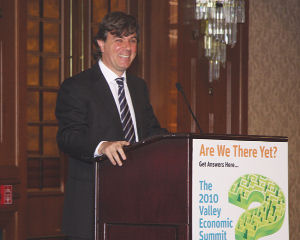Peter Lowy of the Westfield Group real estate company was one of the keynote speakers at the 2010 Valley Economic Summit. He had plenty to say about the future of the company’s growth in Southern California. “California’s economy is broad, diverse and wealthy,” said Lowy. But the biggest problem, in terms of Westfield’s local growth plans, is the state’s budget deficit and poor credit rating, he added. “Westfield has $9 billion in assets in California, but we can’t grow if the state keeps going in the same way,” he said. Business leaders would do well to get involved in the decision making process in Sacramento. Westfield Group is a publicly traded retail real estate company with an equity market capitalization of approx. $27 billion. It has investment interests in 119 shopping centers in the U.S., United Kingdom, Australia and New Zealand. The company’s local portfolio includes the Westfield Topanga mall and neighboring Promenade, Valencia Town Center, and Fashion Square in Sherman Oaks. It has a total of 30 malls in California. Moving forward, Lowy said Westfield is committed to its local investments. And regional malls will be going through some changes. Adaptation is what ensures the success of retail properties, he said, adding Westfield is only doing business with 10 percent of the retailers it was doing business with in 1990. “The key is to be on top of the trends.” In the future, regional malls will be offering a wider range of goods and services, versus just being focused on fashion. There will be more discounter anchor stores, and Lowy wants to get super markets and fitness centers in malls. “There’s no reason Target can’t be in the same mall as Nieman Marcus,” he said, adding Topanga mall is one successful example of blending the two. And the food court model may be a thing of the past. Another major trend is the move from urban sprawl to urban density. Building mixed-use developments that blend retail, residential and easily accessible transportation is one of the company’s focuses. Big box The goal is to not just create shopping centers, said Lowy, but to create an escape that also fosters social interaction. He also wants to bring a larger number of big box retailers under one roof. What about the future of Topanga mall and the Promenade? Lowy said you really can’t compare the two, in terms of their financial performance. Topanga mall, which Westfield bought in 1994, has always performed better than the latter. The Promenade was purchased in 1998 for the purpose of expanding Topanga. One plan is to connect the two and add a mixed use development with residential in-between. But the plan is logistically difficult because there are two major streets that need to be bridged. He said Westfield is very interested in the Valley. But it’s working on a long-term plan for Topanga and the Promenade. “Whether the Promenade will end up the same is a question,” said Lowy. Mixed-use panel One of the panel discussions at the summit, which ties into Lowy’s statements, dealt with L.A.’s mixed use developments. Gene Detchemendy, president of Detchemendy Retail Real Estate, moderated the panel. It discussed what’s working and what’s not in L.A. Mark Salma, director of real estate for Ralph’s, The Kroger Company, talked about the success of Ralph’s downtown, which is part of a mixed use development at 9th and Hope. It was a slam dunk because there was land and demand, he said. “Ralph’s wanted to be there.” The residential component was already under construction. But one of the most difficult parts has been operating a busy commercial complex in a way that does not disturb residents. The company bases its decisions on whether or not to pursue a development largely on sales forecasts. But Salma said it’s also important to think outside of the box. Some of the downtown project’s numbers never penciled out, said Jeff Kreshek of CIM Group, but the demographic intricacies of the area made it work. And residential over retail has been used successfully in Europe and elsewhere for centuries. Be careful But developers need to be careful when mixing residential and retail, said Kreshek. You need to know what tail is wagging the dog, he said. Retail located on the wrong street, or the wrong type of retailer, can kill a project. “You can ruin a project in three retailers or less,” he said. Mixed use has a great future but also has to be done in context with what’s around it, said Brad Rosenheim of Rosenheim & Associates. He has seen some developments not fill up and go back to the city for a variance to change the use to office or medical. “The key is developing the community as well as the development,” said Rosenheim. Negotiating with cities is also tough, he added. Developers need to stand their ground, because there’s a certain point where too many requests from cities will kill a project’s viability. One challenge of building mixed-use in L.A. is finding an aggregate amount of land, said Christopher Alan, CEO of Dasher Lawless. So his company focuses on finding niche properties that are too arduous for larger developers to piece together. And adequate parking is key. “If you can’t park it you’re not going to build it,” said Alan. Paige Serden of City National Bank said obtaining financing for mixed use developments boils down to whether the project is financially viable and the developers have experience blending different product types.
